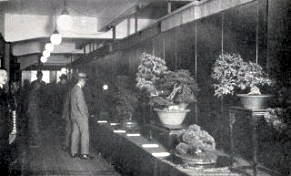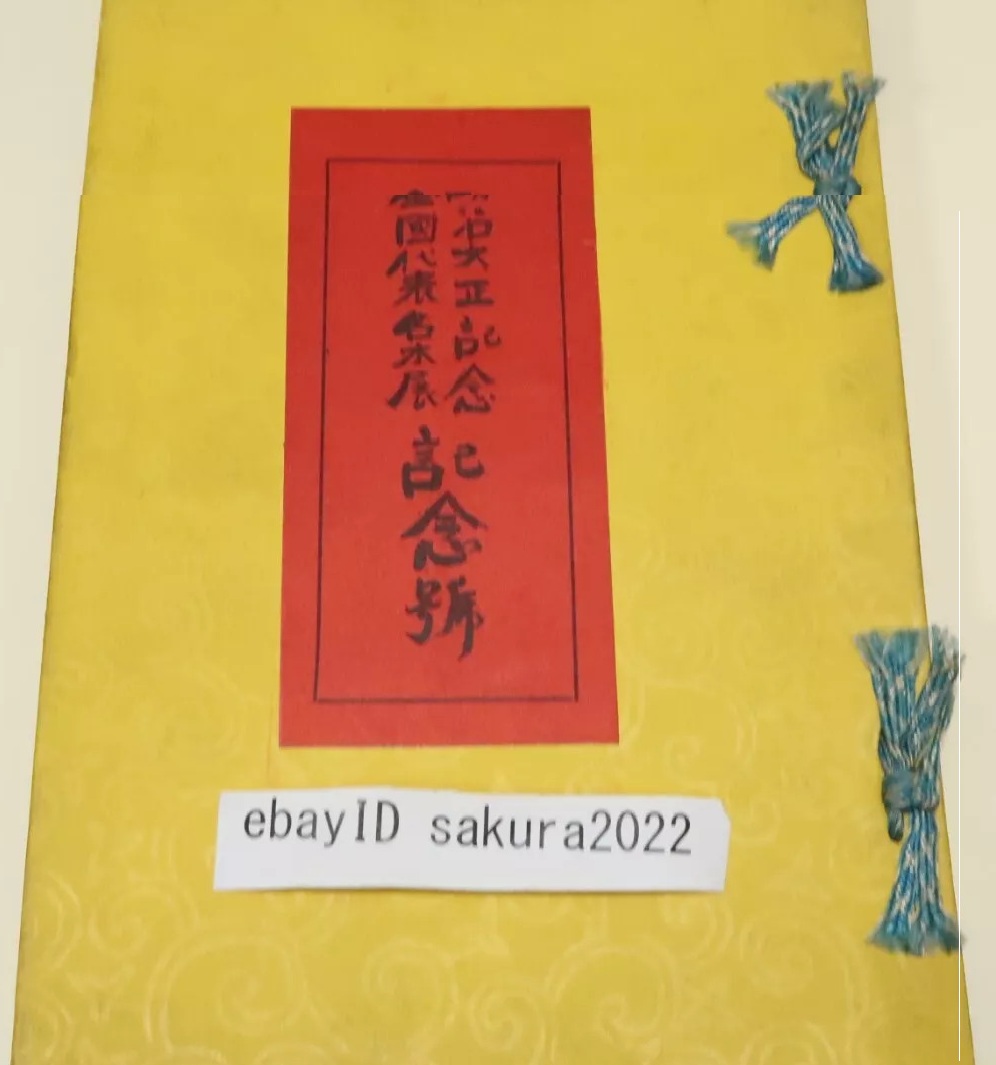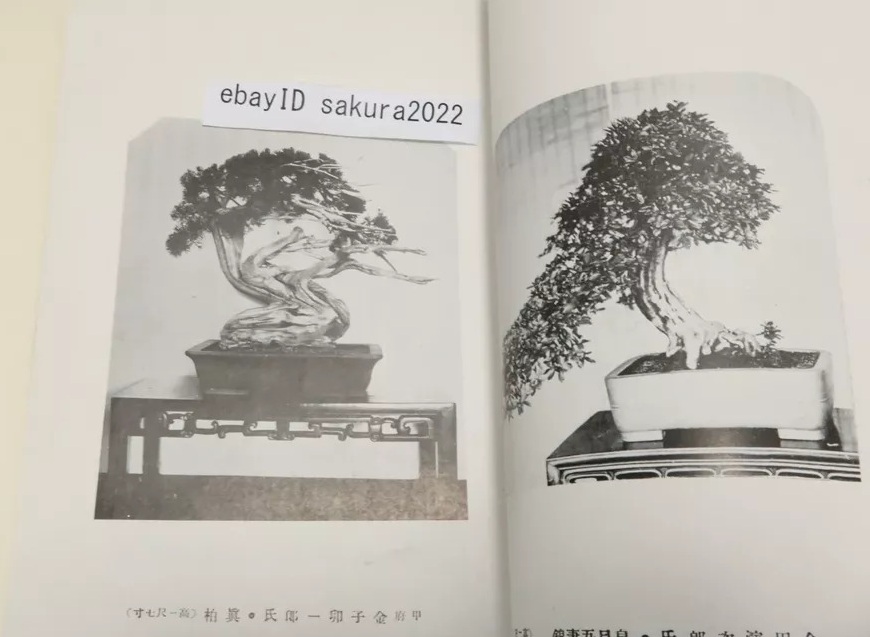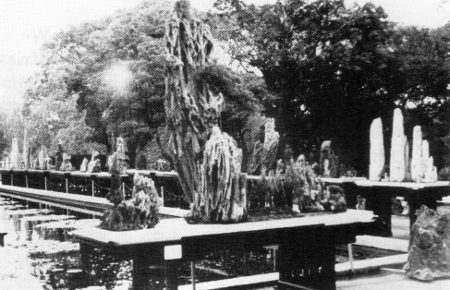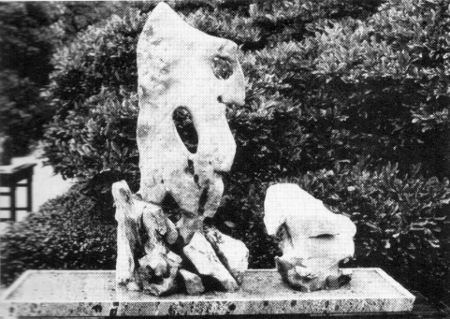| 21 | 2008 -- H. Ismail Saleh passed away at age 82 in a hospital in Jakarta. [The funeral would take place in his family cemetery in his hometown, Cirebon, West Java.] (Saleh was the founder of the Asia Pacific Bonsai & Suiseki Convention & Exhibition, adviser of the Indonesian Bonsai Society (PPBI), special member of the Nippon Bonsai Association (NBA), President Emeritus of the Asia-Pacific Bonsai Friendship Federation (ABFF), and Director of WBFF, Asia Pacific Region. He started the ABFF International Bonsai Photo Contest, aka the Ismail Saleh Trophy.) ("Mr. H. Ismail Saleh SH" obituary, The Bonsai Blog of Robert Steven, http://blogs.knowledgeofbonsai.org/robert_steven/news/, accessed 02/14/2009) SEE ALSO: A Tribute to Ismail Saleh |
| 22 |
2000 -- Connie Addenbrooke Hinds died in a retirement complex in Palo Alto, California.
(Born on April 13, 1913 in Winettka, Illinois, she married Horace Hinds, Jr. and resided in Glen Ellyn, IL for a
number of years. They became interested in the art of bonsai, relatively new to Westerners, but freezing
weather took its toll on their small collection. Moving to Mountain View, California in the early 1950s they
began to study bonsai in earnest -- pausing for a brief residency in Venezuela where Horace, a dairy executive,
set up powdered milk processing plants. The couple returned to Mountain View in 1957 and then joined the
Kusamura Bonsai Club in Palo Alto, once an
all-Japanese group whose doors were opened to non-Japanese by Tosh Saburomaru. Connie studied under Tosh and
his new teacher Yuji Yoshimura as early as 1960 and 1961. While Connie was the bonsai artist in the family,
Horace was the CEO. He became Bonsai Clubs Association President in 1964, and editor of the BCA Newsletter
the following year. The couple began to enlarge both the scope and subscribership, adding paid advertisements
and photographs to the six pages and 200 copies per issue. The magazine came to life in 1966 as Bonsai,
Magazine of Bonsai, Japanese Gardens & Suiseki. In two years 1,200 people were receiving the 15 page
issues. For many years the couple became worldwide organizers, promoting bonsai and helping to establish
satellite groups over the globe. In 1972 Horace became BCI Executive Secretary. The couple's darkest
hour came in November 1974 when Horace had lung surgery (from which he would recover slowly); Connie continued to
put together the 26 page issues for 2,600 members. At the height of their bonsai adventure their personal
garden held over 800 trees and 50 suiseki. In 1977, Connie and Horace stepped back to become Editors
Emeriti. Horace died in late 1991, and Connie, growing outdoor terrace bonsai, continued to attend meetings
of both the Kusamura and Midori Clubs, the latter
also dating from those early days.)
Horace and Connie Hinds, July 1974, receiving a proclamation honoring them by BCI president Beverly Oliver.
("BCI's Mom and Pop: Connie & Horace Hinds" by Mike Halle and John Planting,
Bonsai Magazine, BCI, March/April 2001, pp. 33-34; "Leaders From The Sixties Into The Nineties,"
Bonsai Magazine, BCI, November/December 1993, Vol. XXXII, No. 6, pp. 23-24; "Hindsight On BCI" by Tom Heitkamp,
Bonsai Magazine, BCI, January/February 1978, p. 4-5)
(Juyne M. Tayson, M.D. (ed), International Bonsai Digest Bonsai Gems, Fall 1974, pg. 89) 2011 - The two-day 5th Chinese Bonsai Academic Forum started today at the Green Land Villa in Jiangbei District, Ningbo city (about 120 kilometers to the southeast of Hangzhou in Zhejiang province). More than one hundred experts and masters from all over the country attended the seminar. There was an award ceremony for the fourth group of Chinese Bonsai Masters and the second group of Chinese Bonsai Artists, and the Lifetime Achievement Award for Hu LeGuo, Pan ZhongNian and He GanSun, respectively, for their contributions to the development of Chinese Bonsai. There was a Bonsai Creation Show in the Villa in the afternoon. (The next day, the World Bonsai Cooperation Center would be founded in Green Land Villa. WBFF Chairman Hu YunHua and the Host of the Villa, Yuan XinYi, participated in the unveiling ceremony.) ["The 5th Chinese Bonsai academic forum was held in Ningbo," http://www.wbff-2013.org/indexaction!pbviewbyid.action?pbcId=185] |
| 23 |
|
| 24 |
|
| 25 |
1945 -- Randy T. Clark was born. [When he would be in college studying
photography, Freshman and Sophomore students would only be permitted to work in black and white. It wasn't
until the Junior year that they would be permitted to enroll in color photographic courses. The psychology
was that while color adds a great deal to a photo, it can also be a great distraction from the more important
things a photographer needs to learn such as composition, use of light and shadow, texture, lighting, manipulation
of depth of field, etc, etc. First and second year students needed to master these aspects of the
photographic art and in the beginning, color was considered too much of a "distraction" for beginners to have
to deal with. In the mid-1970s Randy would begin learning the art of bonsai. He would then go on to
spend two terms as president of the Minnesota Bonsai Society
and serve as Chairman of the 1987 International Bonsai Congress Symposium which was held in Minnnesota.
From that event, Randy's book, Outstanding American Bonsai, A Photographic Essay on the Works of Fifty
American Bonsai, would be published September 1, 1989 with photographs by M. Peter Voynovich. It would
showcase the work of 50 outstanding American bonsai artists as the best representation of their work as shown
at the Symposium produced by the National Bonsai Foundation.
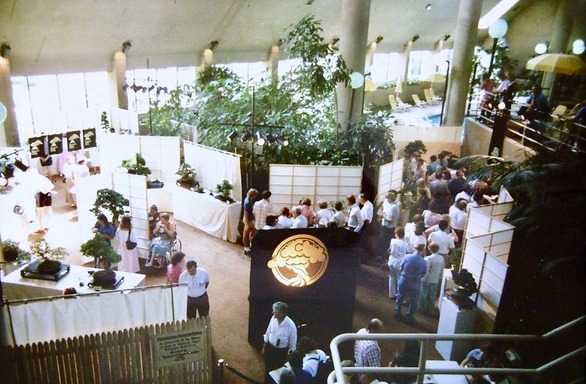
Part of NBF Exhibit, Minnesota 1987
[Since the early 1990s Randy would travel throughout the United States
and Europe teaching the subject. He would strongly encourage his students to develop an individual approach
to the art. His bonsai would win numerous first place and best in show awards at both the local and regional
level. For more than 18 years he would operate the Bonsai Learning Center in Charlotte, North Carolina.
This would be the Southeast's premier location for a full line of bonsai supplies as well as educational programs
for beginner, intermediate and advanced students of the art. Over the years he would be a regular contributor
to avariety of magazines including the ABS Journal, BCI's Bonsai Magazine, Bonsai Today, and
Bonsai Focus. In 1996 and 1997 he would serve as the managing editor of Bonsai Magazine, the
official publication of Bonsai Clubs International. And he would
spend seven years as a vice president of the National Bonsai Foundation
in Washington, D.C. He would write the 11-page
"Beginner's
Basics -- Creating a Bonsai for the First Time" in 2000 for the Bonsai Learning Center in Charlotte, NC, and
also Guidelines For Creating Bonsai
Soil. An article by him entitled "Bonsai & Figurines" would originally appear in Bonsai Today
issue 95 in 2005. In 2013 Randy would retire from being owner of the Bonsai Learning Center and would
move to Leesburg, FL. He would be the consultant webmaster of the
North American Bonsai Federation and serve many years
as webmaster for the North American Bonsai
Federation. The 7th World Bonsai Friendship Federation Convention would be combined with the 12th Asia Pacific Bonsai And Suiseki
Convention in Jin Tan, China and take place on September 24-28, 2013. Randy would be part of a six-man team
from North America along with Bjorn Bjorholm, Brussel Martin, Jack Sustic, Suthin Sukosolvisit, and William N.
Valavanis.]
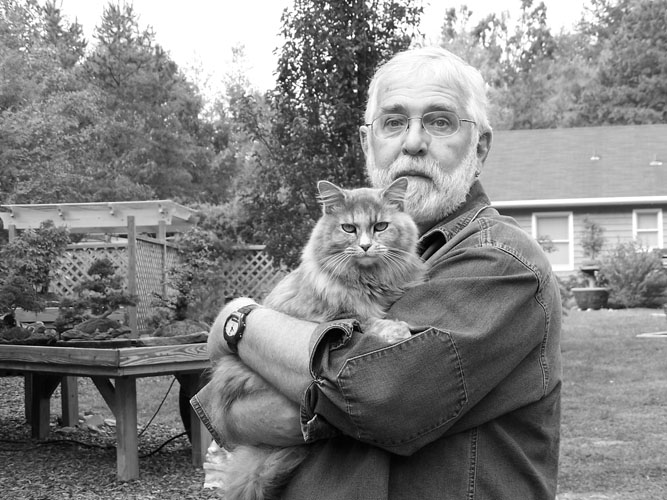
Randy Clark and His Long-time Companion of Over 22 Years, Isis, October 2003 Photo
(Comments to Bonsai
Photos: from Black & White to Colorized and Back, Bonsaibark, 08/18/15;
"How We Got Started," Bonsai Learning Center;
About Our Speakers, Center for Applied Nursery
Research ; "World Bonsai Friendship Federation Convention -- Part I,"
https://valavanisbonsaiblog.com/2013/09/25/world-bonsai-friendship-federation-convention-part-1/, September 25, 2013
; www.bonsailearningcenter.com/IMAGES/PDF%20Files/resume.pdf ; RC emails with RJB on Nov. 30, 2019, including NBF Exhibit
photo) SEE ALSO: Jan 1, Mar 1
|
| 26 |
2001 -- Sona Krishnan died. (He had been born on the 14th of November
1936 at Madurai in the south of Tamilnadu, towards the southern tip of India. [Some 420 kilometers to the
northeast and on the eastern coast of India is the region's largest city, Chennai (formerly called Madras),
India's fourth largest urban center.] Sona received his education at Madurai and was qualified in Tamil
Literature (the region's primary Indian language). By the age of fourteen he had mastered the art of writing
poems and had won several accolades. This drew his interest towards learning more, and so he then mastered
the Hindi literature (the most widely used Indian Language). He also was an artist and developed his hand at
drawing and painting. As a small boy, however, he was mostly inclined towards sculptures and wanted to
someday be a sculptor. Sona's interest in gardening and Bonsai started after his regular visits to the
flower shows held across the country. His penchant for fine arts and love for gardening led to the making of
his first bonsai in the year 1977. There was no looking back in craftsmanship for him from then
onwards. He was the first person to try growing trees in Bricks and Laterite stones. He also tried
growing mame and miniature Bonsai in egg shells. He was considered a person with a 'Midas touch'
for whatever plant he pruned with his hands grew out to be a differently and beautifully styled tree. He had
a special interest for the 'Windswept Style.' His most sought-after tree was the Banyan (Ficus
benghalensis) and all his Banyan trees had Prop (aerial) roots on them. His versatility in designing his
trees made people wonder if he possessed magic wands instead of the normal tools! Such was his style of
crafting. He held many demonstrations on the art of growing Bonsai and there were many students who learned
the art from him. He participated in numerous shows and won several prizes for consecutive years. He
was presented with an honorarium for having taken the art which was known only to the classes to the masses.
He held shows at both educational institutions and commercial organizations. The encouragement and support
of the people led him to write a book on Bonsai. His interest and knowledge of Bonsai culture as well as
Tamil literature led to the publication of the book Tharaiai Thodatha Tharukkal (Trees which never touch
the earth) on 5th September 1987. This book is considered to be the first of its kind in any Indian
language. The book indeed is a blend of art and science. (An English translation of the book is yet to
be published.) His Bonsai collections were featured on television and radio many times as well as in almost
all the regional magazines in Tamilnadu.)
[Personal e-mails to RJB from Navasona Krishnan, Sona's son, 10/17 and 10/20/2002.]
2012 -- The prestigious Woollahra Small Sculpture Prize was unanimously awarded to Australian National University PhD candidate Thorhammer Beowulf. His artwork, "The Carbon Credit Machine," collected the $10,000 acquisitive award. The piece consisted of an living upright Ficus bonsai tree, metal tubing, gauges and other instruments, which led the viewer "on a circuitous journey through the labyrinthine apparatus, only to realise they end up where they began. Nature is the only thing that remains. The process is entirely redundant." In the artist's statement to the judges, Beowulf stated that this is a commentary on environmental science. "With growing concerns about environmental despoliation, climate change and the fragile interdependence between humans with their natural environment, this living bonsai sculpture reveals the absurd hubris of human science and technology in their belief they can replicate or improve upon nature's own perfectly functioning carbon storage and conversion machine, a tree." Forty-two sculptures were chosen out of a total of 494 entries by the preselection judges Guido Belgiorno-Nettis AM (Trustee of the Art Gallery of NSW and Director of the Transfield Foundation) and Natalie Wilson (Assistant Curator of Australian Art at the Art Gallery of NSW). Joining the judging for the final round was Professor Janice Reid AM (Vice-Chancellor of the University of Western Sydney and Trustee of the Art Gallery of NSW). The finalists' works were exhibited over a 16 day period at the historic 'Redleaf' Woollahra Council Chambers in Double Bay, Sydney, Australia. None of the three judges for the Woollahra Small Sculpture Prize had any particular vested interest in bonsai and their impartial decision was therefore even more significant with regards to getting bonsai (in whatever form) introduced and accepted as a legitimate art medium in the mainstream art world. This was the first time in Australia that a bonsai-inspired work had been accepted and then gone on to win a major public art prize in open competition against other general sculpture in Australia. (It may have also possibly been the first such occurrence internationally.) "Of course, not everyone in the bonsai world will appreciate my non-traditional work, but those who don't will have missed the whole point, which is my attempt to break through the barriers of the hegemonic Western art establishment in order to gain recognition for any and all styles of bonsai as legitimate forms of creative artistic expression in the West. Like many others, I believe that bonsai can and should be exhibited in Western art galleries alongside other forms of art. It is the entrenched conservatism of the non-bonsai world towards bonsai which I am challenging and I hope others in the international bonsai community might be inspired to take this further to advance our collective interests." (Thor's family had kept bonsai gardens in Shanghai, China, before World War II, with his mother leaving there after the war when Mao Zedong ordered all Westerners to depart. She then met his Scandanavian father, also an immigrant in Australia who was involved in manufacturing in Sydney. Thor thus inherited a long tradition of bonsai knowledge, growing the trees most of his life. As a teenager, he was further schooled in the art of bonsai by the then-Principal of the Sydney Japanese School, Mr. Yoshida, who had an abiding interest in promoting Japanese arts and culture in Australia. In 2003 Thor curated the first bonsai exhibition of professional bonsai artists at the Art Gallery of New South Wales which was specifically a showcase exhibition of classically-styled trees and not in a competition against other non-bonsai art. With Bachelor of Arts (B.A.) and Bachelor of Social Studies (B.Soc.Stud.) degrees from the University of Sydney, he brought an academic discipline to his ongoing pursuit of knowledge about art theory, aesthetics and bonsai. Following the first limited commercial release of Wollemi Pines on October 2005 through an exclusive Sotheby's auction held at the Royal Botanical Gardens in Sydney, Thor created the world's first authenticated Wollemi Pine bonsai from one of these "Collectors Edition" trees. Since the beginning of 2008, he had been enrolled as a PhD candidate at Australia's leading research university, the Australian National University (ANU), in Canberra. The working title of his doctoral research thesis, "Nature as Art: a Comparative Cross-Cultural Discourse on the Art and Aesthetics of Bonsai", establishes a new benchmark of inquiry into the art and science of bonsai. His eldest son, Thorsten, was a student at the University of Sydney, enrolled in a Bachelor of Horticultural Science degree, and brought horticultural and cutting-edge science to the family business, Bonsai Exotique. Thor's other four sons had also all assisted in this family business, which was the only professional bonsai nursery in the Eastern Suburbs of Sydney. Much of Bonsai Exotique's stock was grown at their bonsai farm in Canberra (some 150 miles or about 241 km to the southwest), but they only exhibit and retail trees at the Woollahra nursery in the heart of Sydney's famous established art and antique street. They also sourced select trees from other bonsai growers and trade in trees and pots from bonsai collectors. A range of bonsai was also occasionally provided for use in advertising and on film sets. All five sons were brought up with bonsai, particularly the endless work of watering, weeding and re-potting, and still assist their father in the nursery from time to time; however, they are actually all on their separate career/lifestyle journeys. Three were at university, one was a tradesman, and the fifth was still in high school. Their mother, Melissa Beowulf (B.A., Dip.Ed (Syd), MArt (COFA, UNSW), was the director of the Beowulf Galleries which specialised in contemporary, Asian and Asian-inspired fine art, sculpture, ceramics and objects d'art with botanical, naturalist or ethnographic themes. The gallery since July 2000 had actively supported and exhibited the works of emerging artists alongside established artists. The gallery hosted Bonsai Exotique.) (Thor's website is Thor Beowulf, Environmental Artist. In 2015, Bonsai Exotique was transformed into the entirely web-based Bonsai Design Studio. The five sons took over the running of the business by July.) 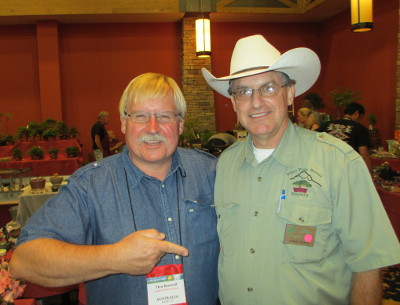
Thorhammer Beowulf and RJB at the ABS/BCI Convention in Denver, CO, June 23, 2012
(Personal emails to RJB from Beowulf, 03 and 05 Nov, 2012; Strachan, Julieanne
"Sculpture
with living bonsai wins prestigious art prize, Canberra Times, Oct. 27, 2012.) SEE ALSO: Aug 6
(Photo by Kenny Asher; we only later found out that that day was Thor's birthday) 2019 - The National Bonsai & Penjing Museum in Washington, DC began one of its most ambitious exhibits ever: Twisted Genius: The Eccentric Bonsai Artistry of Nick Lenz. This gathering of Nick Lenz bonsai and ceramics from three botanical institutions and from sixteen private collections would continue until November 17. (Born in 1940, Andrew Nick Lenz received his B.A. from Stanford University, graduating with honors, and his Masters Degree in Biology from the University of Wisconsin. He was the first environmental designer at Smith College for the first Earth Day and, for a number of years, he had been a restorer of domestic colonial architecture. Nick was a retired University lecturer in Freshwater Ecology. His bonsai career was begun at Stanford over 40 years ago, and continued in what he calls "dismal Wisconsin," and later, in Massachusetts. He considered himself "self-taught" in the art of bonsai, but admited to being heavily influenced by Romanticism that comes from his German heritage. He was of the "old school" of North American bonsai, and very much focused on collected northeastern U.S. and eastern Canadian trees. His attention to detail in the collection process and his training of these materials into bonsai was impressive. Very knowledgeable about Juniperus communis, J. horizontalis, Larix laricina and Thuja occidentalis collecting, rehabilitating, developing, and maintenance, not many people had studied those species as long as he had. He was also recognized as an authority on Malus species. Some people had tried to create a "new style," but Nick Lenz didn't have to: he had a world of his own and his creations are landmarks in the bonsai world. He was the founder of the first line of quality American bonsai pottery known as "Mirkware," but he capped his kiln several years ago and was no longer producing bonsai pottery. Examples of his work appear for sale from time to time, but most pieces are tucked away in private collections. The most sought-after pieces are unusual or unconventional (such as pots with carved faces or free-form shapes) as well as painted landscapes. One particular composition, a larch root-over-reclining statue "Penelope" now living happily in Canada, was returned "home" to the U.S. to be displayed in the 4th US National Bonsai Exhibition on September 13-14, 2014 in Rochester, NY. Perhaps one of the most prolific bonsai practitioners and finest potters in the United States, Nick was often lovingly referred to as a "crazy old hermit" who resided in Massachusetts. He was known for weird and wild bonsai compositions, often using containers and slabs he constructed himself. Bonsai, ceramics, and paintings were involved in his iconic root-over-bone, root-over-gargoyle, root-over-tank, and other unique styles. Some considered him to be the father of bonsai in the United States -- he remained a pioneer in the hobby at the very least. (Nick was a former member of the American Bonsai Society board. He had three dozen articles published in the ABS Bonsai Journal between 1974 and 1997, five more in BCI Bonsai Magazine between 1975 and 2000, three in International Bonsai between 1986 and 1996, one in Bonsai Today in 1991, and one in the UK's Bonsai magazine in 2000. He was also a regular contributor to the online magazine Bonsai Enthusiast in 2001-02 before it merged with Bonsai Today. His book Bonsai from the Wild: The Native Trees Suitable for Bonsai Culture in the Temperate United States and Canada was published by the ABS in 1997; a revised and expanded second edition, Bonsai From the Wild: Collecting, Styling & Caring for Bonsai was published by Stone Lantern Press in 2007. His trees are represented in several public collections, including the Pacific Bonsai Museum, formerly the George Weyerhaeuser Pacific Rim Bonsai Collection, in Federal Way, WA. He was preparing several bonsai for a new home in a Canadian collection. Nick had private bonsai shows in art galleries and at the Boston Museum of Fine Arts. He lectured and taught when he could be "cajoled into breaking his hermit habits." He cared for his private bonsai nursery that was open by invitation only. After years of of parring down his collection, he disseminated his remaining bonsai (to students) in 2018 and retired from maintaining bonsai. His other interests included: Colonial Restoration, Ceramics, Landscape painting, and Religious (Methodist) teaching. His demonstrations had been well-known for their informative, artistic and entertaining qualities. This is a tribute to his work, and this a write-up of it.) 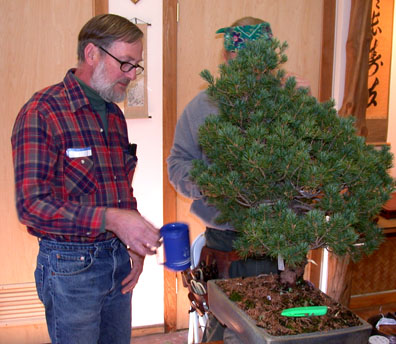
Nick Lenz, 10/25/03. (Photo courtesy of Alan Walker, 05/11/07) ("Is Nick Lenz's Book Outdated?" thread on BonsaiNut, Sept. 5, 2013 ; "Nick Lenz's Larch bonsai Penelope, now living happily in Canada" thread on BonsaiNut, Aug. 4, 2014 ; "ALT-Bonsai -- A Nick Lenz Retrospective" thread on BonsaiNut, July 24-25, 2019 ; Book Review: 'Bonsai from the Wild' by Nick Lenz," The Art of Bonsai, Apr 4, 2006 ; "Nick Lenz," American Bonsai Ceramics, January 6, 2017, with several color photos of his ceramics ; Nick Lenz -- Guest Artist, Austin Bonsai Society, February 2002; "Asymmetry mentions Nick Lenz, Feb 2021.) SEE ALSO: Jan 19, Apr 8 2021 - Glenn Allen Reusch, long-time advocate and one of the leaders of viewing stone appreciation in the eastern United States, passed at age 78. (Glenn graduated from Northfield-Macedonia High School in Northfield, Summit County, OH, and then later almost twenty miles to the southeast at Kent State University. He worked at Firestone Tire and Rubber Co. in Decatur, IL for 28 years. (Prior to moving out East, Glenn was a member and President of the Springfield (IL) Bonsai Society. He was one of four founding members of the Potomac Viewing Stone Group (PVSG) in 1999 and remained their secretary (and "driving force") from the inception of this important group until his death. Along with Chris Cochrane, he staged many important stone exhibits in the National Bonsai and Penjing Museum at the U.S. National Arboretum, witnessed by tens of thousands of people. For more than two decades, PVSG held monthly meetings where speakers presented information about varying aspects of stone appreciation. Glenn also was the registrar and one of six organizers for the International Stone Appreciation Symposia held in Grantville, PA from 2002 to 2012. He served on the board of directors of the National Bonsai Foundation beginning in 2002, and also served as co-chair of the 5th World Bonsai Convention held in Washington D.C. in 2005. He organized stone hunting trips in the Appalachian Mountains chain in the eastern U.S. He enjoyed spending time in nature and his hobbies -- including bonsai and suiseki -- reflected this. His passion for numbers led him to enjoy solving mathematical and logic puzzles and he read widely, always enjoying visits to bookstores and book sales on the hunt for his next read.) [To commemorate his passing, the Museum and PVSG would present an exhibit of stones from his collection between July 30 and September 25, 2022. The exhibit would illustrate Glenn's wide-ranging interest and expansive taste in stone collecting, featuring stones from across the world and the United States, including many that he had personally found in nature. And please watch this memorial video at the bottom of his obituary page.]
Glenn & Helen Reusch, 09/06/03. They would be married 36 years. (Photo courtesy of Alan Walker, 05/11/07) ("Passages, October, 2021," VSANA; "October 29, 2021 NBF Board Member Glenn Reusch Passes at 78," NBF; "Glenn Reusch," Wilson Memorial Service; "Museum Exhibit: A Love of Viewing Stones and Stone Collecting," U.S. National Arboretum) SEE ALSO: Feb 16 |
| 27 |
1994 -- The First Bonsai Symposium was held (through the 29th) in the Hotel Royal Pedregal in Mexico City.
It was organized by an established business, "Bazar de Plantas." That organization was based on the idea,
starting in 1991, of a group of bonsai enthusiasts in Mexico who put together a directory with the names of all
the people that were dedicated to the art of bonsai in Mexico, be it as a hobby or commercial business.
[At the end of the Symposium, the idea of founding the Asociacion Mexicana de Bonsai would come up and it would
formally be constituted one year later, in October 1995, together with the First Bonsai Exhibition in the
Museum Del Carmen in Mexico City.]
("Mexico," by Solita D. Tafur Rosade, President of FELAB , WBFF Director of Latin America Region, Latin America
Region, World Bonsai Friendship Federation,
https://web.archive.org/web/20050218034918/http://www.bonsai-wbff.org/rlatinam.shtml,
accessed 01/09/05.)
2010 -- Hiroshi Suzuki, one of the first bonsai teachers in the Bay Area and a respected suiseki artist, passed away today. (He was born in 1928 in Fukushima, Japan where his family operated a successful orchard farm. Hiroshi came to the U.S. in 1957 to work in the Watsonville, California area, utilizing his orchard farm experiences. In 1960, he married Miyuki, with whom he raised two sons. He started bonsai as a hobby on his own because of his memory of the family's bonsai in Japan. A few years later, he joined the San Francisco Bonsai Club under the instruction of the late Bob Kato. Soon Hiroshi and few other members became obsessed with yamadori shimpaku and went every week to the Sierras until the snow kept them out. He also enjoyed experimenting with soil and the study of bonsai display. At this time, the early 1970's, no one else in the bonsai community was paying any attention to these matters. So in a pursuit of excellence and to move on to the next level in bonsai art, Hiroshi formed a new study group called Golden Gate Bonsai Club, where he was the leader and instructor. He worked as the bonsai curator at Kyoto Koi in Santa Rosa until it closed in the mid-1980s. He was a member of the Redwood Empire Bonsai Society (REBS), where he gave demonstrations and led workshops along with Mas Imazumi, and also the Bay Area Bonsai Associates (BABA). Many of the Bay Area's fine sensei went to study with Hiroshi. He gave generously of his time and expertise, leading workshops and demonstrations for GSBF conventions as well as many local clubs. GSBF recognized him with The Circle of Sensei Award in 2004. In addition to his bonsai work, he was also a fine suiseki collector and artist. He joined San Francisco Suiseki Kai in 1982, during its first year. He continued to go stone hunting and carve daiza into his final months and showed some of his best suiseki at the club's annual exhibit in August, 2010. Hiroshi was humble, sincere and generous, donating many beautiful Sierra Junipers for Japanese Master's demonstrations, and giving generously to club members who were not able to go for yamadori. He was also a kind, patient, and sound instructor. In his subtle way, Hiroshi never allowed any compromise that might lower the standard of bonsai. He was preceded in death by his wife Miyuki. He was survived by his son Henry of San Francisco, and his son Alan, daughter-in-law Tina, and grandson Nolan of Portland.) ("Hiroshi Suzuki, 1928 - 2010," by Janet Roth, Golden Statements, March/April 2011, pg. 9, http://www.gsbf-bonsai.org/magazines/2011/v34_02.pdf) SEE ALSO: Nov 3, Dec 24 |
| 28 |
1956 -- One of John Y. Naka's first California junipers was dug today. [Seventeen years later it would
stand 27"H in a round Tokoname pot and have a trunk diameter of 7-1/2 inches. Although the tree would be
exhibited at the 4th Annual Exhibit of the California Bonsai Society (1961), it would not be pictured until it
graced the first color cover of Bonsai Club International's Bonsai magazine in December 1973.]
("Cover Story," Bonsai Magazine, BCI, Vol. XII, No. 10, December 1973, pg. 3.)
1980 -- A 150-year old Ponderosa Pine (Pinus ponderosa), styled for seven years by Dan Robinson, was the first tree included in the new American bonsai collection. It was unveiled at the U.S. National Arboretum on the occasion of the 75th anniversary of the Forest Service. (Both the Arboretum and Forest Service are part of the U.S. Dept. of Agriculture family.) Collected from the Gifford Pinchot National Forest in Washington state, the tree stands 58" tall and has a 14" diameter trunk. High altitude and lack of rainfall naturally dwarfed this presentation specimen in a region where its cousins sometimes grow over 200 feet tall and ("First American Bonsai," Bonsai Journal, ABS, Vol. 14, No. 4, Winter 1980-81, pg. 80) SEE ALSO: Jan 26, Nov 5 2013 -- Mary Holmes Bloomer died at the age of 71 in Sedona, AZ after the long goodbye brought by Alzheimer's. Her leadership qualities, fondness of people and an endearing laugh were the hallmarks of a life well lived. She is survived by photographer husband Peter (with whom she wrote the book Timeless Trees, the U.S. National Bonsai Collection in 1986) and her brother, John.(originally "Mary Bloomer, unknown [sic] - October 28, 2013" obituary, published in Cazenovia Republican on Nov. 14, 2013; Mary Anna Holmes Bloomer, Find-A-Grave) SEE ALSO: Dec 27 |
| 29 |
2024 -- Akio Kondo passed away at age 56 after two months of illness. (He was
the first to apprentice under Kihachiro Kamiya at Kihachi-en and was a Kokufu
prize-winning artist and teacher. Kondo first visited California in 1996 to practice bonsai for a year after
completing his apprenticeship. He offered an intriguing look at the world of professional bonsai by traveling
around California doing demonstrations for bonsai clubs and working on private collections. The trip was an
inspiration to many, including his host for most of the year, Boon Manakitivipart. Boon learned a lot from
Kondo during the visit and cemented a friendship that led, eventually, to Boon's study with Kamiya at Kihachi-en
as the master's third apprentice. Kondo sold his nursery in 2009 so as to be able to travel more, work on trees
across Japan and teach overseas. In early 2011 Kondo was in Northern California to visit the exhibit of
Bay Island Bonsai, to work on client trees, and to teach. While
at the exhibit mid-month, Kondo selected a tree for a new award, the Akio Kondo Bonsai Award. The winning tree
was a Korean hornbeam (Carpinus turczaninovii), 16" tall in a Raho pot, worked on by Jonas Dupuich since 2002.
The trunk was in good shape when Jonas acquired the tree but the branches lacked character so most were removed
or pruned severely, as was the previous apex. Nine years later, the tree was starting to develop a more mature
silhouette. This award included a Japanese bonsai pot and an autographed copy of the 2010
Sakufu-ten show book -- an event at which Kondo took the
second most prestigious prize for exhibiting a beautiful hinoki cypress (Chamaecyparis obtusa) he had worked
on since 2005. Kondo also won prizes at the 2011 - the Nippon Bonsai Association Award for a root-over-rock
trident maple (Acer buergerianum) - and then 2014 Sakufu exhibitions in Japan. (The 2014 40th Sakufu Bonsai Exhibition was held Dec 4 - 7, but its judging was held earlier, as usual, that year on October 15 at the Ueno Green Club. In the morning the bonsai finalists were selected and were moved to the third floor where the final selections would be made. Mr. Fukuda, chairman of the Nippon Bonsai Association and chairman of the World Bonsai Friendship Federation, mentioned that Akio Kondo's award-winning Needle juniper (Juniperus rigida) was rare because it was the only bonsai to have won the Prime Minister Award six times. This beautiful and famous bonsai was originally created by the Suzuki family of Daiju-en Bonsai Garden near Nagoya. The first generation artist Saichi Suzuki won with this bonsai as did his son, Toshinori and his grandson Toru. Mr. Kondo mentioned that he was very honored about his award. This was the 20th time he had entered the Sakufu Bonsai Exhibition, but the first time to win the Prime Minister Award. He continued that he was familiar with this Needle juniper bonsai for a long time and wanted to care for it someday. Three years earlier his dream came true and he was finally the caretaker. He was very honored to have had the opportunity to submit this bonsai again so others could enjoy its beauty." (Kondo headlined the Mid-Atlantic Bonsai Societies' 2017 34th Spring Festival in CT along with Boon.) 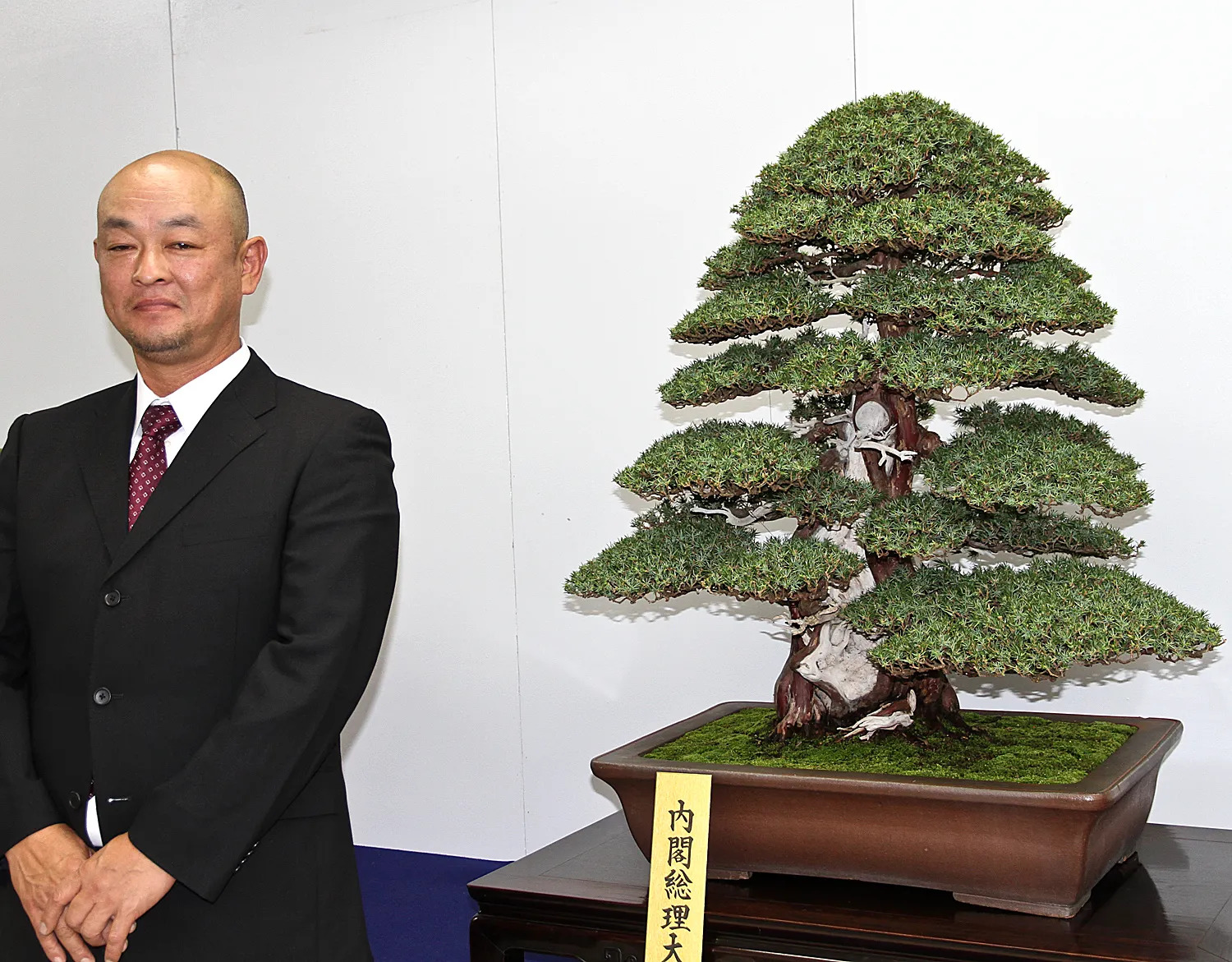
Akio Kondo and Needle Juniper from 2014 Sakufu-ten
("2014 Sakufu Bonsai Judging" by Bill Valavanis) (Boon Manakitivipart's Facebook post on October 30, 2024; Akio Kondo critique," August 24, 2009 by Jonas Dupuich; "Akio Kondo Bonsai Award - 2011," January 25, 2011 by Jonas Dupuich; "Sakufu-ten - the bonsai professional's exhibit," February 7, 2012 by Jonas Dupuich; "2014 Sakufu Bonsai Judging," October 15, 2014 by Bill Valavanis.) SEE ALSO: Jan 28, Jan Also, Dec 5. |
| 30 |
|
| 31 |
1975 -- Australia's First National Bonsai Convention and Show opened today in Sydney. John Naka was the
headliner for the three day event.
("Australian National Bonsai Convention," Bonsai Magazine, BCI, Vol. XIV, No. 6, July-August 1975, pg.
194)
2004 -- Former ABS president Leo Cunningham died at his home in Seattle, WA at age 89.
He was preceded in death by his only daughter and survived by his life-long wife Vernette. 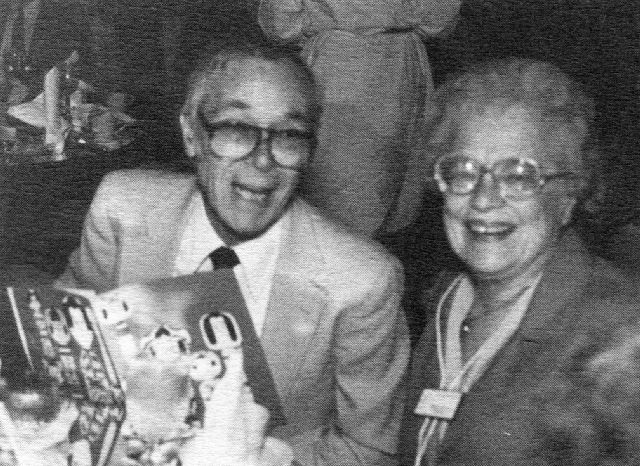
Leo and Vernette Cunningham at the Nashville '87 banquet,
("In Memorium...Leo Cunningham," Bonsai Journal, ABS, Vol. 38, No. 4,
Winter 2004, pg. 17.) SEE ALSO: Jan 26, Mar 8, Oct 7
(ABStracts, ABS, Vol. 15, No. 3, August 1987, pg. 3) |
